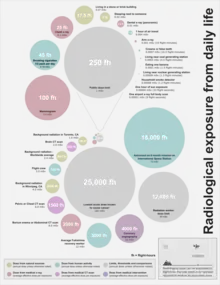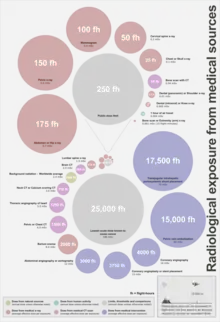Flight-time equivalent dose
Flight-time equivalent dose (FED) is an informal unit of measurement of ionizing radiation exposure. Expressed in units of flight-time (i.e., flight-seconds, flight-minutes, flight-hours), one unit of flight-time is approximately equivalent to the radiological dose received during the same unit of time spent in an airliner at cruising altitude. FED is intended as a general educational unit to enable a better understanding of radiological dose by converting dose typically presented in sieverts into units of time. FED is only meant as an educational exercise and is not a formally adopted dose measurement.


History
The flight-time equivalent dose concept is the creation of Ulf Stahmer, a Canadian professional engineer working in the field of radioactive materials transport. It was first presented in the poster session[1] at the 18th International Symposium of the Packaging and Transport of Radioactive Materials (PATRAM) held in Kobe, Hyogo, Japan where the poster received an Aoki Award for distinguished poster presentation.[2] In 2018, an article on FED[3] appeared in the peer-reviewed journal The Physics Teacher.
Usage
Flight-time equivalent dose is an informal measurement, so any equivalences are necessarily approximate. It has been found useful to provide context between radiological doses received from various every-day activities and medical procedures.
Dose calculation
FED corresponds to the time spent in an airliner flying at altitude required to receive a corresponding radiological dose. FED is calculated by taking a known dose (typically in millisieverts) and dividing it by the average dose rate (typically in millisieverts per hour) at an altitude of 10,000 m, a typical cruising altitude for a commercial airliner.
While radiological dose at cruising altitudes varies with latitude, for FED calculations, the radiological dose rate at an altitude of 10,000 m has been standardized to be 0.004 mSv/h,[4] about 15 times greater than the average dose rate at the Earth's surface. Using this technique, the FED received from a 0.01 mSv panoramic dental x-ray is approximately equivalent to 2.5 flight-hours; the FED received from eating one banana is approximately equal to 1.5 flight-minutes; and the FED received each year from naturally occurring background radiation (2.4 mSv/year[5]) is approximately equivalent to 600 flight-hours.
Radiological exposures and limits
For comparison, a list of activities (including common medical procedures) and their estimated radiological exposures are tabulated below. Regulatory occupational dose limits for the public and radiation workers are also included. Items on this list are represented pictorially in the accompanying illustrations.
| Activity | Event Type | Dose | FED |
|---|---|---|---|
| Airport x-ray full body scan | singular | 0.00001 mSv[6] | 9 flight-seconds |
| One hour of sun exposure | singular | 0.00004 mSv[5] | 36 flight-seconds |
| Household smoke detector | annual | 0.00008 mSv[7] | 1.2 flight-minutes |
| Living near a nuclear generating station | annual | 0.00009 mSv[7] | 1.3 flight-minutes |
| Eating one banana | singular | 0.0001 mSv[8] | 1.5 flight-minutes |
| Living near a coal generating station | annual | 0.0003 mSv[7] | 4.5 flight-minutes |
| Crowns or false teeth | annual | 0.0007 mSv[7] | 10.5 flight-minutes |
| Bone scan or extremity (arm) x-ray | singular | 0.001 mSv[9] | 15 flight-minutes |
| One hour of air travel | singular | 0.004 mSv[4][10][11][12] | 1 flight-hour |
| Dental (intraoral) or knee x-ray | singular | 0.005 mSv[9] | 1.2 flight-hours |
| Dental (panoramic) or shoulder x-ray | singular | 0.01 mSv[9] | 2.5 flight-hours |
| Sleeping next to someone | annual | 0.02 mSv[13] | 5 flight-hours |
| Bone scan with CT | singular | 0.04 mSv[9] | 10 flight-hours |
| Living in a stone or brick building | annual | 0.07 mSv[7] | 17.5 flight-hours |
| Chest or skull x-ray | singular | 0.1 mSv[9] | 25 flight-hours |
| Smoking cigarettes (1/2 pack per day) | annual | 0.18 mSv[14] | 45 flight-hours |
| Cervical spine x-ray | singular | 0.2 mSv[9] | 50 flight-hours |
| Mammogram | singular | 0.4 mSv[9] | 100 flight-hours |
| Pelvic x-ray | singular | 0.6 mSv[9] | 150 flight-hours |
| Abdomen or hip x-ray | singular | 0.7 mSv[9] | 175 flight-hours |
| Public dose limit | limit | 1 mSv[15] | 250 flight-hours |
| Lumbar spine x-ray | singular | 1.5 mSv[9] | 375 flight-hours |
| Background radiation in Toronto, CA | annual | 1.6 mSv[5] | 400 flight-hours |
| Brain CT scan | singular | 2 mSv[9] | 500 flight-hours |
| Background radiation - worldwide average | annual | 2.4 mSv[5] | 600 flight-hours |
| Flight crew | annual | 3 mSv[4][10][11][12][16] | 750 flight-hours |
| Neck CT or calcium scoring CT | singular | 3 mSv[9] | 750 flight-hours |
| Background radiation in Winnipeg, CA | annual | 4 mSv[5] | 1000 flight-hours |
| Thoracic angiography of heart | singular | 5 mSv[9] | 1250 flight-hours |
| Pelvic or chest CT scan | singular | 6 mSv[9] | 1500 flight-hours |
| Barium enema | singular | 8 mSv[9] | 2000 flight-hours |
| Average Fukishima recovery worker | singular | 12 mSv[17] | 3000 flight-hours |
| Abdominal angiography or aortography | singular | 12 mSv[9] | 3000 flight-hours |
| Coronary angioplasty or stent placement | singular | 15 mSv[9] | 3750 flight-hours |
| Coronary angiography | singular | 16 mSv[9] | 4000 flight-hours |
| Radiation worker dose limit | limit | 50 mSv[15] | 12,500 flight-hours |
| Pelvic vein embolization | singular | 60 mSv[9] | 15,000 flight-hours |
| Transjugular intrahepatic portosystemic shunt placement | singular | 70 mSv[9] | 17,500 flight-hours |
| Astronaut on 6 month ISS mission | singular | 72 mSv[18] | 18,000 flight-hours |
| Lowest acute dose known to cause cancer | singular | 100 mSv[19][20] | 25,000 flight-hours |
See also
- Background radiation
- Background radiation equivalent time
- Banana equivalent dose
- List of unusual units of measurement
References
- Stahmer, U. 11 – 16 September 2016. Flight-Time Equivalent Dose - A Concept to Contextualize Radiological Dose. 18th International Symposium of the Packaging and Transport of Radioactive Materials (PATRAM). Kobe, Hyogo, Japan.
- Nuclear Waste Management Organization (2016). Engineer Wins Award for Best Poster. Retrieved 10 December 2021.
- Stahmer, U. (2018-10-24). "Using Flight-Time to Contextualize Radiological Dose". The Physics Teacher. 56 (8): 508–511. doi:10.1119/1.5064556. S2CID 125730267. Retrieved 2022-04-28.
- Friedberg, W; Copeland K (2011). "Ionizing Radiation in Earth's Atmosphere and in Space Near Earth" Civil Aerospace Medical Institute, Federal Aviation Administration, DOT/FAA/AM- 11/9.
- Grasty, R.L.; LaMarre, J.R. (2004-02-01). "The annual effective dose from natural sources of ionising radiation in Canada". Radiation Protection Dosimetry. 108 (3): 215–226. doi:10.1093/rpd/nch022. PMID 15031443. Retrieved 2022-04-28.
- "AAPM Report No. 217 Radiation Dose from Airport Scanners" (PDF). American Association of Physicists in Medicine. June 2013. Retrieved 26 April 2022.
- "Calculate your radiation dose". United States Environmental Protection Agency. 3 October 2014. Retrieved 2022-04-26.
- Mansfield, G. (1995-03-08). "Banana Equivalent Dose". RadSafe -- The International Radiation Protection (Health Physics) Mailing List. Retrieved 2022-04-28.
- Mettler, F.A.; Huda, W.; Yoshizumi, T.T.; Mahesh, M. (2008). "Effective Doses in Radiology and Diagnostic Nuclear Medicine: A Catalog". Radiology. 248 (1): 254–63. doi:10.1148/radiol.2481071451. PMID 18566177. Retrieved 2022-04-26.
- Reitz, G. (1993-05-01). "Radiation Environment in the Stratosphere". Radiation Protection Dosimetry. 48 (1): 5–29. doi:10.1093/oxfordjournals.rpd.a081837. Retrieved 2022-04-28.
- Shea, M.A.; Smart, D.F. (August 2001). Comment on Galactic Radiation Dose to Air Crews. 27th International Cosmic Ray Conference. Bibcode:2001ICRC...10.4071S.
- Bennett, L.G.I.; Lewis, B.J.; Bennett, M.J.; McCall, M.J.; Bean, M (2013). "A Survey of the Cosmic Radiation Exposure of Air Canada Pilots during Maximum Galactic Radiation Conditions in 2009". Radiation Measurements. 49 (1): 103–108. doi:10.1016/j.radmeas.2012.12.004. Retrieved 2022-04-28.
- Borham, D. (27 October 2010). "Human health and the biological effects of tritium in drinking water". Slide 16. Retrieved 2022-04-26.
- "Report No. 160 – Ionizing Radiation Exposure of the Population of the United States". National Council on Radiation Protection and Measurements. 3 March 2009. Retrieved 26 April 2022.
- ICRP, International Commission on Radiological Protection. "Dose limits". ICRPedia. ICRP. Retrieved 26 April 2022.
- Bailey, S. (2000). "Air crew radiation exposure – An overview" (PDF). Nuclear News. 43 (1): 32–40. Retrieved 2022-04-26.
- United Nations Environment Programme (2016). Radiation Effects and Sources. United Nations Environment Programme. doi:10.18356/b1749f17-en. ISBN 9789210599597.
- Cucinotta, F.A. (January 1, 2007). "Space Radiation Organ Doses for Astronauts on Past and Future Missions" (PDF). NASA Technical Reports Server. Retrieved 26 April 2022.
- "Radiation Health Effects". Canadian Nuclear Safety Commission. 3 February 2014. Retrieved 2022-04-26.
However, studies to date have not been able to show any excess cancers or other diseases in people chronically exposed to radiation at doses lower than about 100 mSv.
- "Backgrounder on Biological Effects of Radiation". Biological Effects of Radiation. United States Nuclear Regulatory Commission. 2020-07-08. Retrieved 2022-04-28.
The data show high doses of radiation may cause cancers. But there are no data to establish a firm link between cancer and doses below about 10,000 mrem (100 mSv – 100 times the NRC limit).